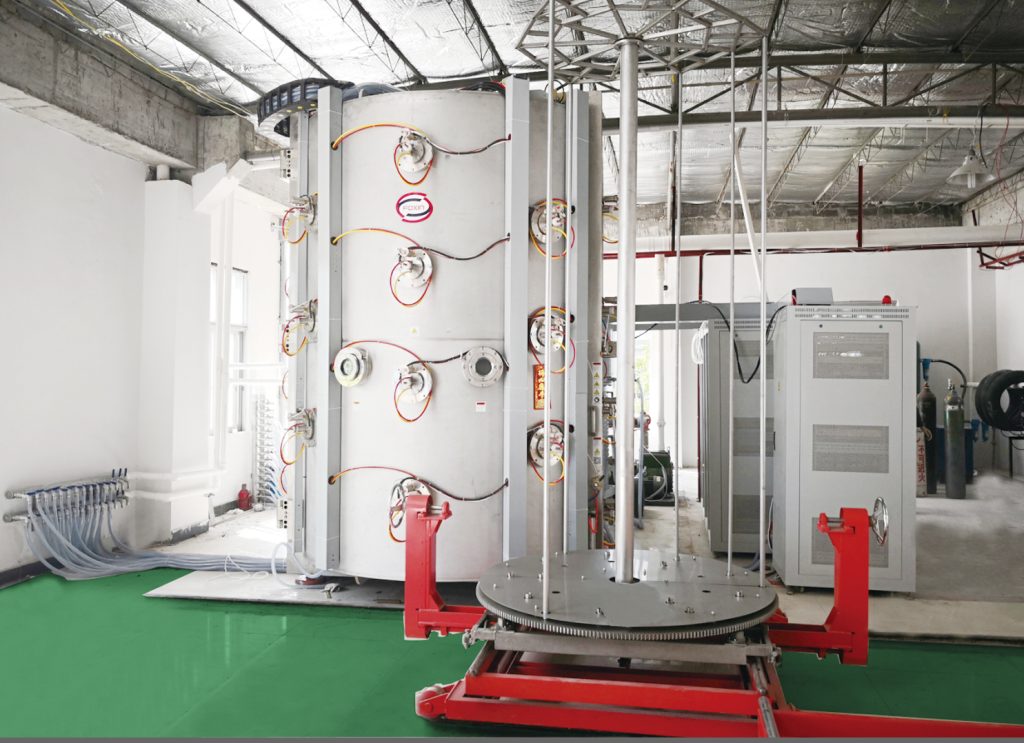
News
12 Year Pvd Coating Machine In Foxin
Difference between water plating and vacuum plating
First we need to understand the fundamentals of each of them
Working Principle:
Water plating is a process that involves adding metal ions to a workpiece using an electric current in a solution. This process results in the formation of a metal coating on the surface of the workpiece. This creates a metal coating on the surface of the workpiece. The process takes place in a liquid and requires an electrolyzer and a power supply to deliver the current.
Vacuum Coating: This is a physical vapor deposition process that takes place in a vacuum environment. The object is placed in a vacuum chamber. A thin film material is then added to its surface. This is done using methods such as evaporation or sputtering.

Scope of application:
Water plating is a method of coating metal surfaces using electrolysis. It is commonly used for materials like copper, chrome, and nickel.
Vacuum plating: suitable for surface coating of various materials, including metals, ceramics, plastics, etc.
Coating properties:
Water plating (electrolytic plating): coatings are usually thicker and provide better corrosion resistance and conductivity. However, they may not be as thin and uniform as vacuum coatings.
Vacuum Coating: Films are typically thinner and have a more uniform thickness distribution because they are applied in a vacuum environment. This method can be used to create high performance applications such as optical films and anti-reflective coatings.
Complexity and cost:
Water plating uses simple equipment and operation, but needs treatment of electrolyte and wastewater, which can cause environmental and health issues. Costs are usually low.
Vacuum plating: more complex equipment, requires maintenance of a vacuum environment, and has higher technical requirements. Costs can be high, especially in high performance coating applications.
What is vacuum coating technology?
Evaporation Deposition: Evaporation and deposition of thin film materials onto the surface of an object by heating them. This can be achieved by electron beam heating, resistance heating or laser heating.
Sputter Deposition: Gas ions hit solid material and transfer it to a surface using an electric field in a vacuum chamber. This produces a uniform film and can be performed at different angles.
Chemical Vapor Deposition (CVD):
Magnetron Sputtering: This is a sputtering technique that increases the rate of deposition of thin films by introducing a magnetic field to increase the efficiency of ion bombardment.
Electron Beam Evaporation (EBE): An electron beam is used to heat thin film materials, causing them to evaporate and be deposited on the surface of an object. This method is common in the preparation of high quality thin films.
Molecular Beam Epitaxy (MBE): Mainly used to grow single crystal thin films, thin film materials are deposited layer by layer by controlling the impact of the molecular beam.
PVD can be achieved by a variety of methods, the most common of which include:
Evaporation Deposition: A solid thin film material is heated in a vacuum chamber to evaporate and deposit on the surface of an object. The evaporated film material forms a coating by condensation on a cooled substrate.
Sputter Deposition: A solid thin film material is sputtered onto the surface of an object by ion bombardment with an electric field applied in a vacuum environment. Vapors of the material produced by the sputtering process are deposited on the substrate.

Advantages of PVD technology include:
Film uniformity: PVD technology can produce relatively uniform films, which is important in many applications such as optical coatings.
Material purity: Because it takes place in a vacuum environment, PVD can often produce high purity films for applications that require high purity materials.
Precision control: The PVD process can be used to control the nature and thickness of the film by adjusting parameters such as heating temperature, gas flow, and ion bombardment.
PVD (Physical Vapor Deposition) technology has a wide range of applications in several industries.
Optics and optoelectronics: PVD is used to prepare optical coatings such as mirrors, anti-reflective coatings, filters, etc. to improve the performance of optical components.
Electronics industry: In the manufacture of semiconductors and electronic devices, PVD technology is used to prepare metal connecting wires, electronic films, etc. to improve the conductivity and connectivity of electronic components.
Decorative and Jewelry Industry: PVD is used to prepare thin metal films on jewelry and accessories to give them an attractive appearance and color.
Automotive and Aerospace: PVD films can be used to improve the surface hardness, abrasion and corrosion resistance of automotive and aircraft components to increase performance and longevity.
PVD tech makes medical device coatings safer by reducing irritation and infection risks on surfaces.
Cutting Tools and Tooling: PVD technology can be used to prepare coatings for blades, knives and drills to improve their wear, corrosion and cutting properties.
Solar & Energy: PVD can be used to prepare transparent conductive coatings for solar cells, improving photovoltaic conversion efficiency.
Sanitary industry: PVD technology can be used to prepare corrosion-resistant coatings on faucets, bathroom fittings, etc. to extend their service life.
In the battery industry, PVD is used to make coatings for battery electrodes, which helps improve battery performance.
PVD technology is important for many industries. It creates thin films by converting solid materials in a vacuum. These films have specific properties and functions, making them useful for surface coatings in various applications.
